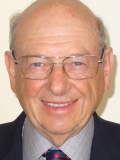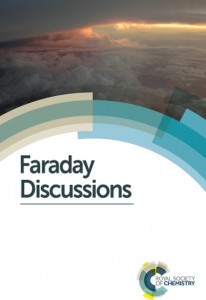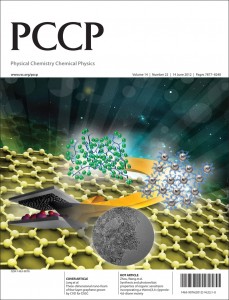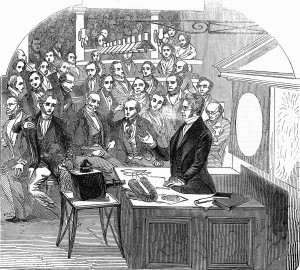 We are pleased to present the most read articles in Faraday Discussions in 2012.
We are pleased to present the most read articles in Faraday Discussions in 2012.
Attending a Faraday Discussion is a unique opportunity to discuss your work with leading researchers in important areas of physical chemistry, biophysical chemistry and chemical physics. Faraday Discussions are a unique and high-impact series of international conferences. Each Discussion is on a specific “hot topic”, and 24 papers are presented and discussed by world class speakers. The 24 papers and discussion (including new research presented by any delegate) are published in the Faraday Discussions journal.
The journal is SCI indexed, and the latest Impact Factor is 5.0.
Join us in 2013 for some excellent discussions: http://rsc.li/fd-upcoming-meetings.
Sign up to receive our free table-of-contents e-alert when each new volume goes online.
Top 25 most-read Faraday Discussions articles for 2012
Realizing artificial photosynthesis
Devens Gust, Thomas A. Moore and Ana L. Moore
DOI: 10.1039/C1FD00110H
Ionic Liquids: Past, present and future
C. Austen Angell, Younes Ansari and Zuofeng Zhao
DOI: 10.1039/C1FD00112D
Artificial photosynthesis for solar fuels
Stenbjörn Styring
DOI: 10.1039/C1FD00113B
Electron transfer kinetics in water splitting dye-sensitized solar cells based on core–shell oxide electrodes
Seung-Hyun Anna Lee, Yixin Zhao, Emil A. Hernandez-Pagan, Landy Blasdel, W. Justin Youngblood and Thomas E. Mallouk
DOI: 10.1039/C1FD00083G
Excitons and charges at organic semiconductor heterojunctions
Richard H. Friend, Matthew Phillips, Akshay Rao, Mark W. B. Wilson, Zhe Li and Christopher R. McNeill
DOI: 10.1039/C1FD00104C
Graphene-based supercapacitors in the parallel-plate electrode configuration: Ionic liquids versus organic electrolytes
Youngseon Shim, Hyung J. Kim and YounJoon Jung
DOI: 10.1039/C1FD00086A
Hydrogen evolution on nano-particulate transition metal sulfides
Jacob Bonde, Poul G. Moses, Thomas F. Jaramillo, Jens K. Nørskov and Ib Chorkendorff
DOI: 10.1039/B803857K
Development of highly efficient supramolecular CO2 reduction photocatalysts with high turnover frequency and durability
Yusuke Tamaki, Katsuhiro Watanabe, Kazuhide Koike, Haruo Inoue, Tatsuki Morimoto and Osamu Ishitani
DOI: 10.1039/C1FD00091H
Design principles of photosynthetic light-harvesting
Graham R. Fleming, Gabriela S. Schlau-Cohen, Kapil Amarnath and Julia Zaks
DOI: 10.1039/C1FD00078K
Artificial leaf device for solar fuel production
Yutaka Amao, Naho Shuto, Kana Furuno, Asami Obata, Yoshiko Fuchino, Keiko Uemura, Tsutomu Kajino, Takeshi Sekito, Satoshi Iwai, Yasushi Miyamoto and Masatoshi Matsuda
DOI: 10.1039/C1FD00097G
Surface enhanced Raman spectroscopy: new materials, concepts, characterization tools, and applications
Jon A. Dieringer, Adam D. McFarland, Nilam C. Shah, Douglas A. Stuart, Alyson V. Whitney, Chanda R. Yonzon, Matthew A. Young, Xiaoyu Zhang and Richard P. Van Duyne
DOI: 10.1039/B513431P
Physical constraints on charge transport through bacterial nanowires
Nicholas F. Polizzi, Spiros S. Skourtis and David N. Beratan
DOI: 10.1039/C1FD00098E
A Ga2O3 underlayer as an isomorphic template for ultrathin hematite films toward efficient photoelectrochemical water splitting
Takashi Hisatomi, Jérémie Brillet, Maurin Cornuz, Florian Le Formal, Nicolas Tétreault, Kevin Sivula and Michael Grätzel
DOI: 10.1039/C1FD00103E
Micro-convection, dissipative structure and pattern formation in polymer blend solutions under temperature gradients
Takeshi Nambu, Yuji Yamauchi, Takahiro Kushiro and Shinichi Sakurai
DOI: 10.1039/B403108C
Light-driven water oxidation with a molecular tetra-cobalt(III) cubane cluster
Giuseppina La Ganga, Fausto Puntoriero, Sebastiano Campagna, Irene Bazzan, Serena Berardi, Marcella Bonchio, Andrea Sartorel, Mirco Natali and Franco Scandola
DOI: 10.1039/C1FD00093D
Kinetics of light-driven oxygen evolution at α-Fe2O3 electrodes
Laurence M. Peter, K. G. Upul Wijayantha and Asif A. Tahir
DOI: 10.1039/C1FD00079A
The interface ionic liquid(s)/electrode(s): In situ STM and AFM measurements
Frank Endres, Natalia Borisenko, Sherif Zein El Abedin, Robert Hayes and Rob Atkin
DOI: 10.1039/C1FD00050K
Copper dioxygen (bio)inorganic chemistry
Edward I. Solomon, Jake W. Ginsbach, David E. Heppner, Matthew T. Kieber-Emmons, Christian H. Kjaergaard, Pieter J. Smeets, Li Tian and Julia S. Woertink
DOI: 10.1039/C005500J
Simultaneous frequency and dissipation factor QCM measurements of biomolecular adsorption and cell adhesion
Michael Rodahl, Fredrik Höök, Claes Fredriksson, Craig A. Keller, Anatol Krozer, Peter Brzezinski, Marina Voinova and Bengt Kasemo
DOI: 10.1039/A703137H
Accumulative electron transfer: Multiple charge separation in artificial photosynthesis
Susanne Karlsson, Julien Boixel, Yann Pellegrin, Errol Blart, Hans-Christian Becker, Fabrice Odobel and Leif Hammarström
DOI: 10.1039/C1FD00089F
Colloidal metal oxide particles loaded with synthetic catalysts for solar H2 production
Fezile Lakadamyali, Masaru Kato and Erwin Reisner
DOI: 10.1039/C1FD00077B
Nanoparticle catalysts with high energy surfaces and enhanced activity synthesized by electrochemical method
Zhi-You Zhou, Na Tian, Zhi-Zhong Huang, De-Jun Chen and Shi-Gang Sun
DOI: 10.1039/B803716G
Gold nanoparticle-polymer/biopolymer complexes for protein sensing
Daniel F. Moyano, Subinoy Rana, Uwe H. F. Bunz and Vincent M. Rotello
DOI: 10.1039/C1FD00024A
A novel self-healing supramolecular polymer system
Stefano Burattini, Howard M. Colquhoun, Barnaby W. Greenland and Wayne Hayes
DOI: 10.1039/B900859D
Bio-tribology
Duncan Dowson
DOI: 10.1039/C2FD20103H

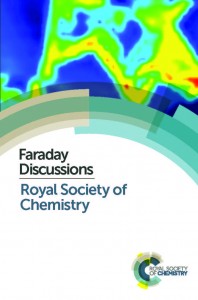 Check out these HOT articles which have recently been published as Accepted Manuscripts in Faraday Discussions:
Check out these HOT articles which have recently been published as Accepted Manuscripts in Faraday Discussions:











